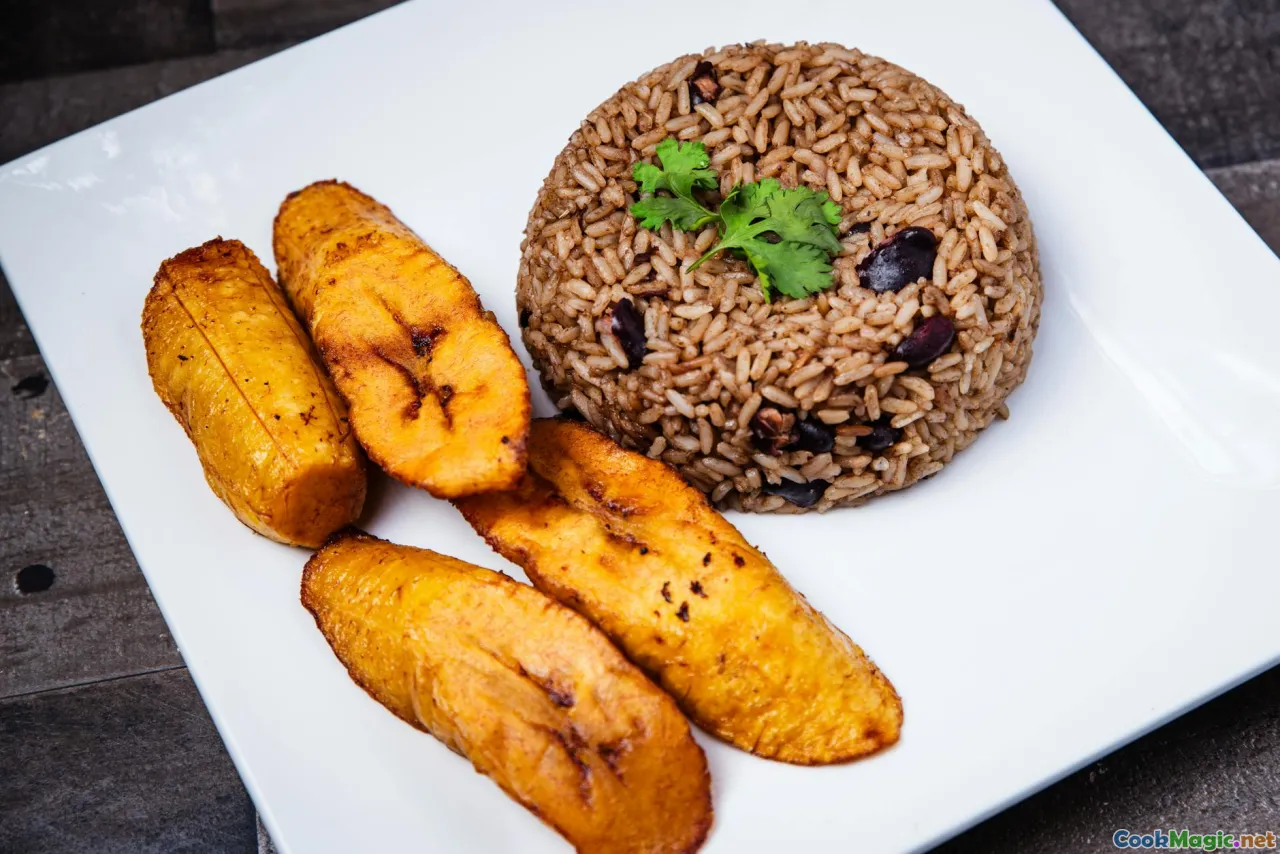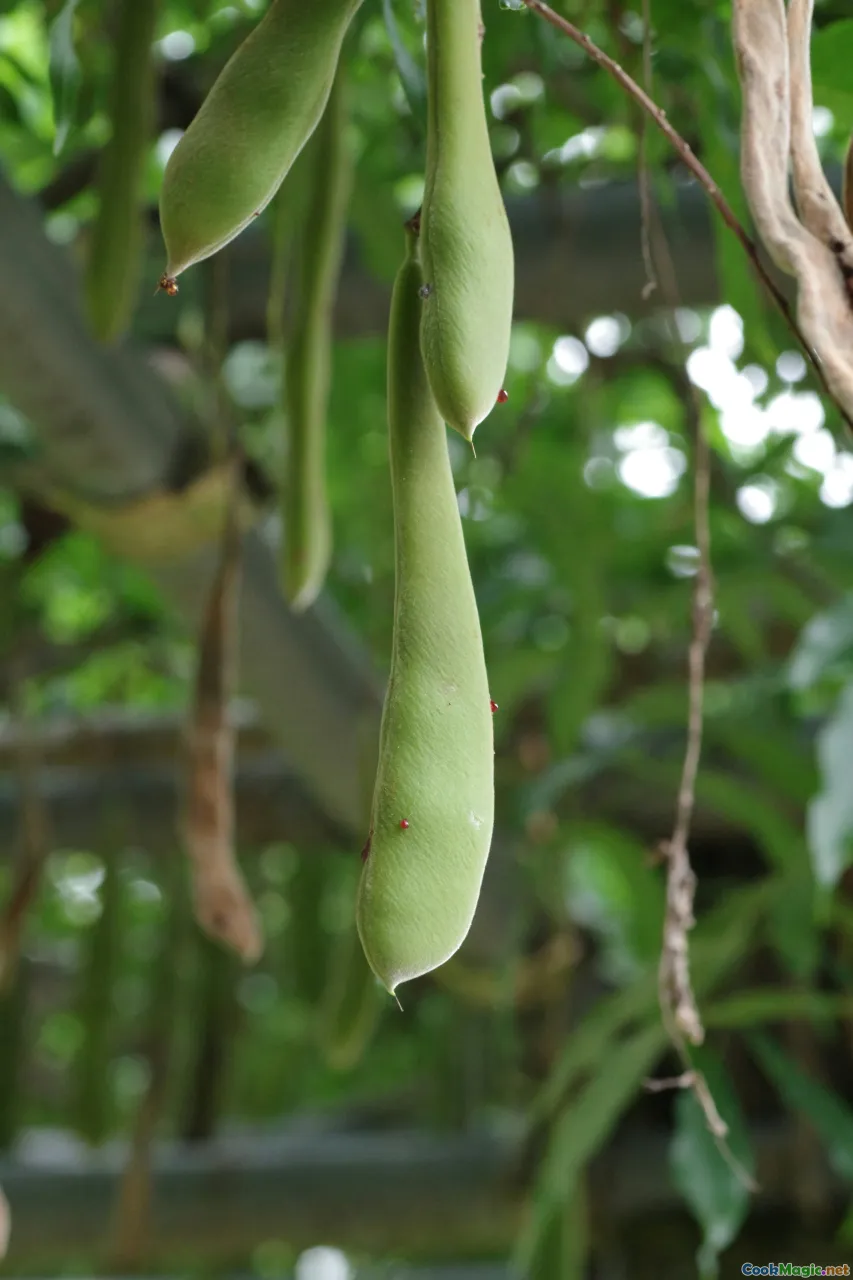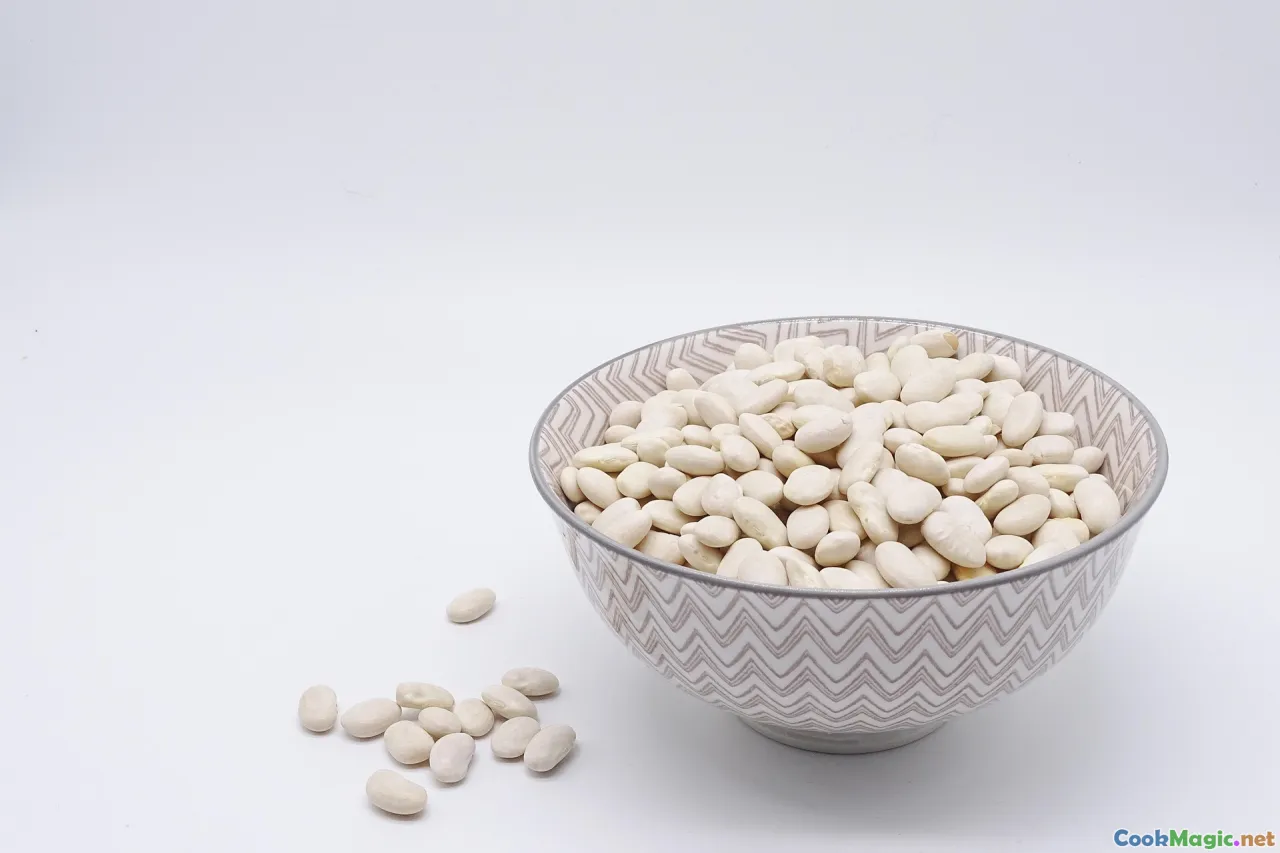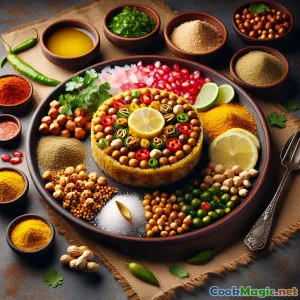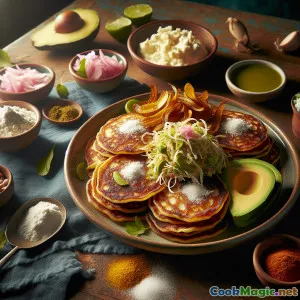
Baleadas al fiore di platano con fagioli e avocado
(Plantain Blossom Baleadas with Beans and Avocado)
(0 Recensioni)0
141
ottobre 13, 2025
Segnala un problema
Ingredienti
-
350 grams Farina 00
(For the baleada tortillas)
-
1 tsp Sale fine
(Condimento per l'impasto)
-
1 tsp Lievito in polvere
(Light lift for soft tortillas; traditionalists may omit)
-
180 ml Acqua tiepida
(Add gradually until a soft dough forms)
-
3 tbsp Olio neutro o strutto
(Manteca (lard) for classic flavor)
-
2 medium Platani maturi
(Yellow with black freckles for sweetness)
-
2 tbsp Burro non salato o olio neutro
(For sautéing plantains)
-
1 tbsp Zucchero di canna chiaro
(Boosts caramelization on plantains)
-
500 grams Fagioli rossi rifriti
(Prefer Central American red beans; black beans also work)
-
1 clove Aglio (tritato)
(Sauté into beans for aroma)
-
0.5 tsp Cumino macinato
(Warm spice for beans)
-
120 ml crema honduregna o panna acida
(Smooth, lightly tangy)
-
120 grams Formaggio fresco sbriciolato
(Can sub queso duro blanco or feta)
-
1 large Avocado
(Affettato sottile)
-
0.25 cup Coriandolo fresco (tritato)
(Herbal freshness)
-
0.5 cup Cipolle rosse sott'aceto
(Bright bite to balance richness)
-
1 medium Lime
(Wedges for squeezing)
-
2 tbsp Salsa piccante
(Chimol or any preferred hot sauce)
-
1 cup Fiore di banana, lavato e tagliato a strisce sottili
(Optional slaw; sub finely shredded cabbage if unavailable)
-
2 tbsp Succo di lime (per blossom slaw)
(Brightens banana blossom slaw)
-
0.25 tsp Sale marino (per slaw di fiori)
(Season to Taste)
(For the baleada tortillas)
(Condimento per l'impasto)
(Light lift for soft tortillas; traditionalists may omit)
(Add gradually until a soft dough forms)
(Manteca (lard) for classic flavor)
(Yellow with black freckles for sweetness)
(For sautéing plantains)
(Boosts caramelization on plantains)
(Prefer Central American red beans; black beans also work)
(Sauté into beans for aroma)
(Warm spice for beans)
(Smooth, lightly tangy)
(Can sub queso duro blanco or feta)
(Affettato sottile)
(Herbal freshness)
(Bright bite to balance richness)
(Wedges for squeezing)
(Chimol or any preferred hot sauce)
(Optional slaw; sub finely shredded cabbage if unavailable)
(Brightens banana blossom slaw)
(Season to Taste)
Nutrizione
- Porzioni: 4
- Dimensione Porzione: 1 baleada (250g)
- Calories: 620 kcal
- Carbohydrates: 0 g
- Protein: 15 g
- Fat: 26 g
- Fiber: 13 g
- Sugar: 12 g
- Sodium: 820 mg
- Cholesterol: 25 mg
- Calcium: 220 mg
- Iron: 4 mg
Istruzioni
-
1 - Make tortilla dough:
In a bowl, whisk flour, salt, and baking powder (if using). Add warm water and 2 tbsp oil/lard; mix until shaggy. Knead 3–4 minutes until smooth and supple. Cover and rest 15 minutes.
-
2 - Prep plantains:
Peel ripe plantains. Slice on a steep bias into 1/4-inch ovals. For a blossom fan, lightly score 3–4 cuts halfway across each slice without cutting through.
-
3 - Caramelize plantains:
Heat butter/oil in a skillet over medium. Add plantain slices in a single layer; cook 2–3 minutes per side to deep golden. Sprinkle a pinch of brown sugar and salt to glaze. Keep warm.
-
4 - Warm and season beans:
In a small pan, heat 1 tsp oil. Sauté garlic until fragrant, 30 seconds. Stir in refried beans and cumin; loosen with a splash of water if thick. Keep over low heat.
-
5 - Portion and roll tortillas:
Divide rested dough into 6 equal balls for large baleadas. Lightly oil the counter. Roll each ball into a 7–8 inch round; keep covered to prevent drying.
-
6 - Cook tortillas:
Heat a comal or heavy skillet over medium-high. Cook tortillas 60–90 seconds per side until puffed and lightly mottled. Brush with remaining oil/lard. Stack in a towel to steam-soften.
-
7 - Optional banana blossom slaw:
If using, toss banana blossom shreds with lime juice and salt. Squeeze gently to reduce bitterness. Let stand 3 minutes to lightly pickle.
-
8 - Assemble the baleadas:
Spread a generous layer of hot refried beans on a warm tortilla. Add crema, arrange plantain slices in a flower fan, then top with avocado, queso fresco, cilantro, and pickled onions. Squeeze lime and add hot sauce. Fold in half and serve immediately.
In a bowl, whisk flour, salt, and baking powder (if using). Add warm water and 2 tbsp oil/lard; mix until shaggy. Knead 3–4 minutes until smooth and supple. Cover and rest 15 minutes.
Peel ripe plantains. Slice on a steep bias into 1/4-inch ovals. For a blossom fan, lightly score 3–4 cuts halfway across each slice without cutting through.
Heat butter/oil in a skillet over medium. Add plantain slices in a single layer; cook 2–3 minutes per side to deep golden. Sprinkle a pinch of brown sugar and salt to glaze. Keep warm.
In a small pan, heat 1 tsp oil. Sauté garlic until fragrant, 30 seconds. Stir in refried beans and cumin; loosen with a splash of water if thick. Keep over low heat.
Divide rested dough into 6 equal balls for large baleadas. Lightly oil the counter. Roll each ball into a 7–8 inch round; keep covered to prevent drying.
Heat a comal or heavy skillet over medium-high. Cook tortillas 60–90 seconds per side until puffed and lightly mottled. Brush with remaining oil/lard. Stack in a towel to steam-soften.
If using, toss banana blossom shreds with lime juice and salt. Squeeze gently to reduce bitterness. Let stand 3 minutes to lightly pickle.
Spread a generous layer of hot refried beans on a warm tortilla. Add crema, arrange plantain slices in a flower fan, then top with avocado, queso fresco, cilantro, and pickled onions. Squeeze lime and add hot sauce. Fold in half and serve immediately.
Ulteriori informazioni su: Baleadas al fiore di platano con fagioli e avocado
Why These Baleadas Bloom
Plantain Blossom Baleadas take the beloved Honduran street staple and nudge it into playful territory. Traditional baleadas are thick, tender flour tortillas folded around creamy refried red beans, crema, queso, and sometimes avocado or scrambled egg. In this version, ripe plantain slices are scored and fanned into “petals,” creating a visual bloom that adds caramelized sweetness to the savory, tangy core. The result is a dish that’s comforting like the classic, but with a tropical wink that makes every bite feel celebratory.
A Quick History and Cultural Notes
Baleadas originated along the north coast of Honduras and are now a national favorite, enjoyed morning to midnight. The base remains constant: a soft, substantial tortilla—the heart of the dish—paired with beans. Crema and queso add dairy richness, while optional toppings reflect regional preferences and what’s on hand. You’ll find them from roadside stands to bustling markets, where the rhythm of slapping dough onto a hot comal is part of the culinary soundtrack. Our plantain twist nods to the Caribbean influence along the Honduran coast, where ripe plantains often appear alongside beans, rice, and seafood.
Ingredient Spotlight
- Tortillas: A touch of baking powder keeps them supple and a little puffy. Lard (manteca) offers classic flavor, but neutral oil works well for a vegetarian-friendly base.
- Beans: Central American red beans have a gentle sweetness; refried black beans are a fine stand-in. Keep them spreadable, not stiff.
- Plantains: Ripe (yellow with black freckles) is key. They caramelize easily and deliver a honeyed, custardy contrast to the beans.
- Crema and Queso: Honduran crema is lightly tangy and pourable; queso fresco crumbles into creamy-salty nuggets.
- Optional Banana Blossom Slaw: Banana flowers are common in tropical markets; a quick lime cure reduces bitterness. Cabbage is a practical substitute.
Technique Tips for Success
- Dough Rest Matters: Even 15 minutes of resting relaxes gluten so tortillas roll thinly and cook evenly.
- Heat Management: A properly preheated comal gives you blisters and light char without drying the tortillas. If they stay pale, turn up the heat; if they become brittle, lower it.
- Plantain Caramelization: Don’t crowd the pan. Give slices room so edges crisp and sugars caramelize. A pinch of brown sugar assists, but ripe fruit alone can do the job.
- Bean Consistency: If beans are too thick, stir in warm water or a spoon of crema. You want a spread that clings but doesn’t clump.
- Assembly While Warm: Keep tortillas in a towel-wrapped stack. Warm components meld, turning each fold into a saucy, creamy package.
Variations and Substitutions
- Classic Baleada: Skip plantains and blossom slaw; add scrambled eggs (desayuno-style).
- Protein Boost: Add grilled chicken strips, chorizo, or seared shrimp for a heartier meal.
- Dairy-Free: Use dairy-free crema and skip queso; add pickled onions and extra avocado for richness.
- Whole-Grain Twist: Swap 25–30% of the flour for whole-wheat flour; add a splash more water.
Make-Ahead, Storage, and Reheating
- Tortillas: Cook, cool, and refrigerate up to 3 days or freeze a month. Reheat in a dry skillet, 30–45 seconds per side.
- Beans: Cool and refrigerate up to 4 days; rewarm with a splash of water.
- Plantains: Best fresh, but you can par-cook and finish to order.
- Banana Blossom Slaw: Keeps 1–2 days; the lime cure softens it over time.
Serving and Pairing
Serve with lime wedges and your favorite hot sauce. A simple side of curtido-style cabbage or a crisp salad balances richness. For drinks, try maracuyá juice, a light lager, or a hibiscus agua fresca.
Troubleshooting
- Dry Tortillas: Increase resting time or add a teaspoon of water to the dough. Brush with a dot of oil post-cook.
- Pale, Dense Tortillas: Raise skillet heat and roll slightly thinner.
- Mushy Plantains: They were overripe or cooked over low heat. Use medium heat and avoid overcrowding.
Why the “Blossom” Works
The scored, fanned plantain slices do more than look pretty. Their increased surface area crisps slightly, catching crema and queso in the ridges. Against the soft tortilla and silky beans, the plantain bloom is both textural and visual, signaling a dish that embraces tradition while blossoming into something new.
Final Notes
As with all great street foods, the magic is in the balance: a tender tortilla, creamy beans, sunny-sweet plantain, cool dairy, and a flash of acid and heat. Keep components warm and build quickly—the moment you fold, the baleada becomes greater than the sum of its parts. Whether you make them for breakfast, a casual dinner, or a late-night snack, Plantain Blossom Baleadas deliver comforting Honduran soul with a bright, tropical twist.

